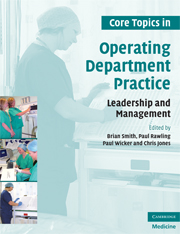Book contents
- Frontmatter
- Contents
- List of contributors
- Foreword
- Preface
- 1 Managing change in perioperative education
- 2 The role of the operating department manager within the context of the organization
- 3 Action learning: a new way of problem solving in perioperative settings
- 4 Agenda for change: what do theatre staff need to know?
- 5 The SWOT analysis: its place in strategic planning in a modern operating department
- 6 Corporate governance: setting the scene for perioperative practice
- 7 Managing different cultures: adversity and diversity in the perioperative environment
- 8 Leadership in perioperative settings: a practical guide
- 9 Management and leadership of advanced practice
- 10 Managing conflict in perioperative settings
- 11 The management and organization of emergency operating lists
- 12 Organizational culture
- 13 Development matters in the NHS; including a perioperative approach to the KSF
- 14 Equipment procurement: a purchaser's guide for theatre managers
- 15 The reflective practitioner in perioperative settings
- 16 New ways of working in perioperative practice
- 17 Damned if you do and damned if you don't: whistle blowing in perioperative practice
- 18 A manager's experience of recruitment and retention
- 19 The management of change
- Index
- References
16 - New ways of working in perioperative practice
- Frontmatter
- Contents
- List of contributors
- Foreword
- Preface
- 1 Managing change in perioperative education
- 2 The role of the operating department manager within the context of the organization
- 3 Action learning: a new way of problem solving in perioperative settings
- 4 Agenda for change: what do theatre staff need to know?
- 5 The SWOT analysis: its place in strategic planning in a modern operating department
- 6 Corporate governance: setting the scene for perioperative practice
- 7 Managing different cultures: adversity and diversity in the perioperative environment
- 8 Leadership in perioperative settings: a practical guide
- 9 Management and leadership of advanced practice
- 10 Managing conflict in perioperative settings
- 11 The management and organization of emergency operating lists
- 12 Organizational culture
- 13 Development matters in the NHS; including a perioperative approach to the KSF
- 14 Equipment procurement: a purchaser's guide for theatre managers
- 15 The reflective practitioner in perioperative settings
- 16 New ways of working in perioperative practice
- 17 Damned if you do and damned if you don't: whistle blowing in perioperative practice
- 18 A manager's experience of recruitment and retention
- 19 The management of change
- Index
- References
Summary
Key Learning Points
Recognize the need for evidence-based practice in perioperative care
Understand how clinical governance can improve the quality of patient care
Examine the role of clinical risk management on practice and quality improvement
Recognize what innovation is and how it can help in delivering efficient patient care
Introduction
Quality in the NHS is viewed as a major issue, borne out by the NHS executive document Clinical Governance: Quality in the New NHS (Department of Health 1999a). This raises the question as to why Trusts are apparently not working very quickly towards achieving the aims set out in this document. Is the question ‘What do you perceive to be your Trust's “quality improvement strategy”?’ a source of mirth in operating departments? Some colleagues may well suggest that none of the three words quality, improvement and strategy should actually be used singly within the workplace let alone together in one sentence. It is a little disappointing that operating departments, and disconcerting for operating department managers, if this reaction takes place. This chapter will question how quality can be improved in operating departments when the management is perceived to be constrained by cost; it will do so by exploring innovation. It must also be considered how patients perceive the care they receive (Hewison 2004).
- Type
- Chapter
- Information
- Core Topics in Operating Department PracticeLeadership and Management, pp. 134 - 145Publisher: Cambridge University PressPrint publication year: 2009



